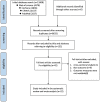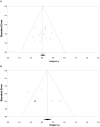The effect of exercise on walking economy in patients with chronic neurological conditions: A systematic review and meta-analysis
- PMID: 36712424
- PMCID: PMC9874330
- DOI: 10.3389/fneur.2022.1074521
The effect of exercise on walking economy in patients with chronic neurological conditions: A systematic review and meta-analysis
Abstract
Introduction: To investigate the effect of exercise on the walking economy (WE) of patients with chronic neurological conditions (CNCs) and to determine the type of physical activity that best improves the WE of patients with CNCs.
Methods: Four electronic databases were searched until December 2022 (Web of Science, PubMed, Cochrane, and CINAHL). Studies were screened using the following inclusion criteria: 1. randomized controlled or non-randomized controlled trials; 2. exercise interventions >4 weeks in duration; 3. patients aged ≥18 years with a diagnosis of CNCs. 4. walking economy of patients measured before and after the intervention. The PEDro scale was used to assess the methodological quality of the included studies.
Results and discussion: Twenty-two studies met the inclusion criteria. Meta-analysis results showed that exercise significantly improved WE (g = -0.352, 95% CI, -0.625 to -0.078, P = 0.012). Subgroup analysis revealed that patients who received exercise showed better WE compared with those who underwent no control intervention (g = -0.474, 95% CI, -0.636 to -0.311, P < 0.001). However, exercise therapy did not show a significant improvement of WE compared with control groups (g = -0.192, 95% CI, -0.451 to 0.067, P = 0.146). In addition, we found that endurance combined with resistance, high-intensity intermittent, and other training modalities resulted in better WE compared with the pre-intervention. Of these, interval training has the greatest effect on improving WE. In conclusion, exercise can improve WE in patients with CNCs. More randomized controlled trials are necessary for the future.
Systematic review registration: https://www.crd.york.ac.uk/prospero/display_record.php?ID=CRD42022361455, identifier: CRD42022361455.
Keywords: chronic neurological conditions; energy cost; exercise; rehabilitation; walking.
Copyright © 2023 Liu, Yu, Fan, Hao, Wu, Xiao, Yu and Ren.
Conflict of interest statement
The authors declare that the research was conducted in the absence of any commercial or financial relationships that could be construed as a potential conflict of interest.
Figures



References
-
- Organization WH . The World Health Report 2007: A Safer Future: Global Public Health Security in the 21st century. World Health Organization. (2007).
-
- Cahn DA, Sullivan EV, Shear PK, Pfefferbaum A, Heit G, Silverberg G. Differential contributions of cognitive and motor component processes to physical and instrumental activities of daily living in Parkinson's disease. Arch Clin Neuropsychol. (1998) 13:575–83. 10.1016/S0887-6177(98)00024-9 - DOI - PubMed
Publication types
LinkOut - more resources
Full Text Sources
Miscellaneous

